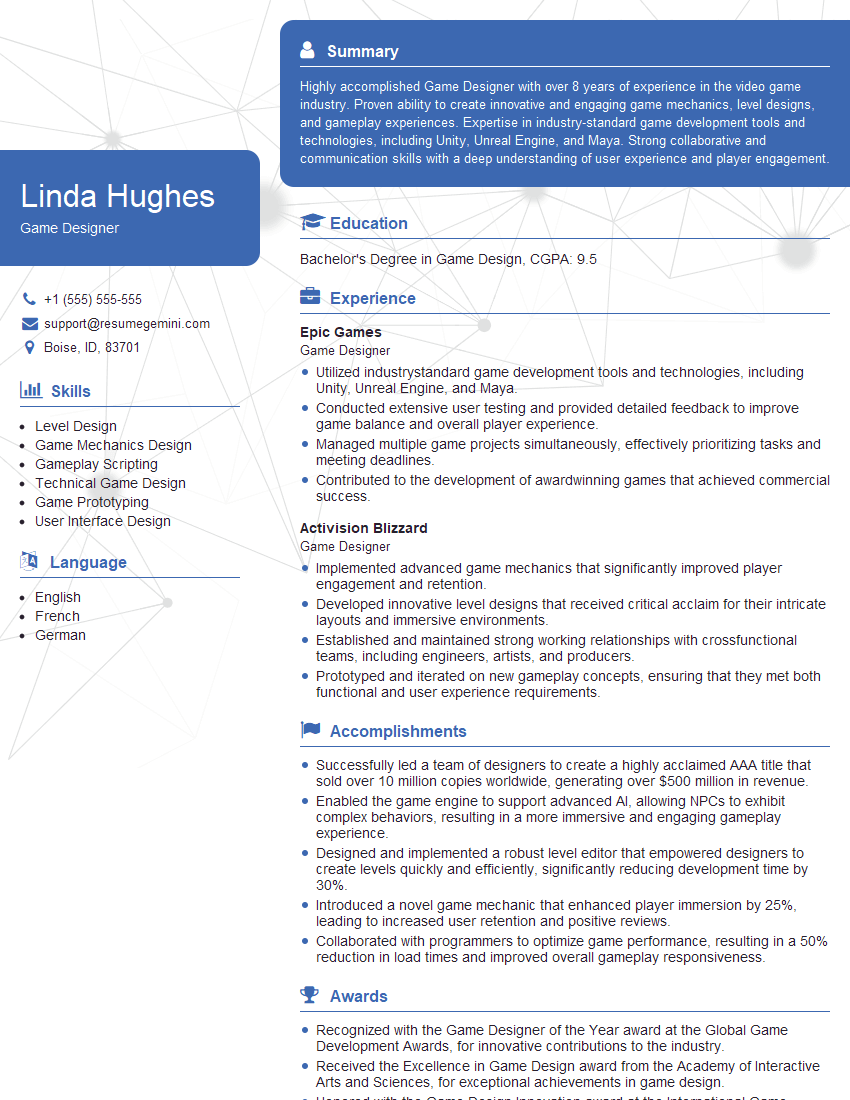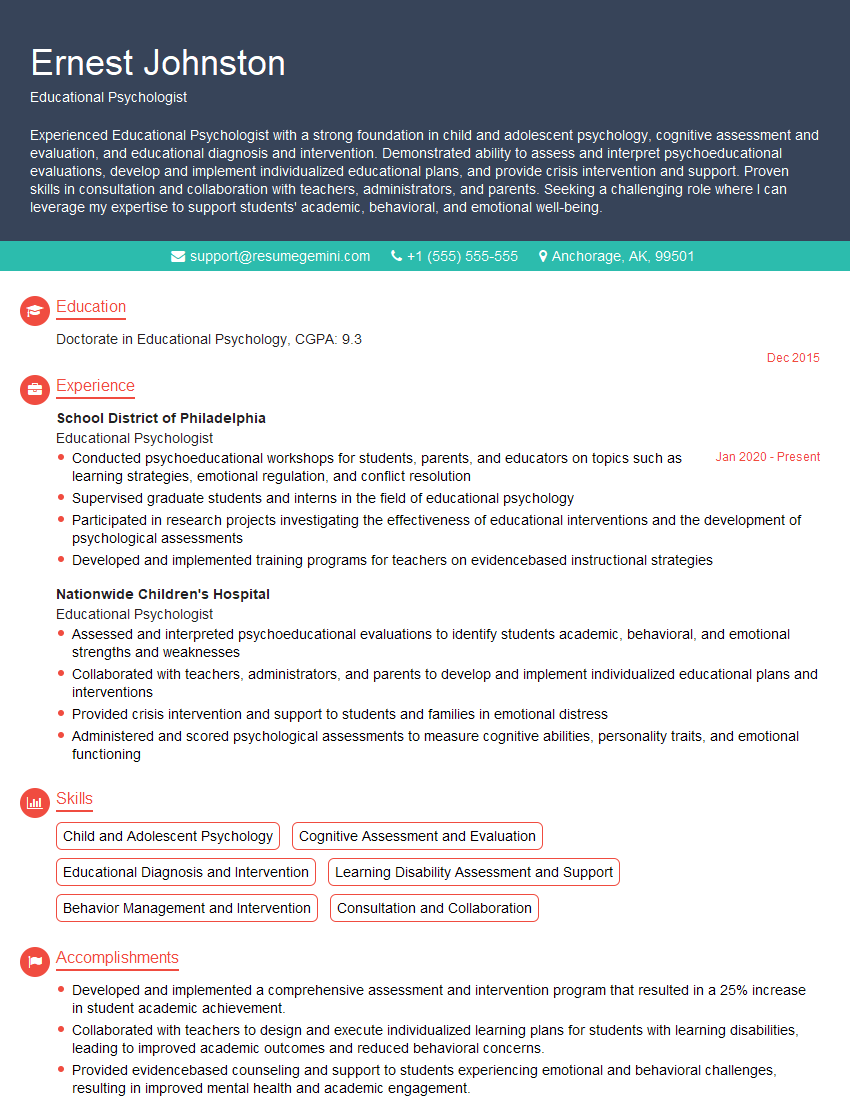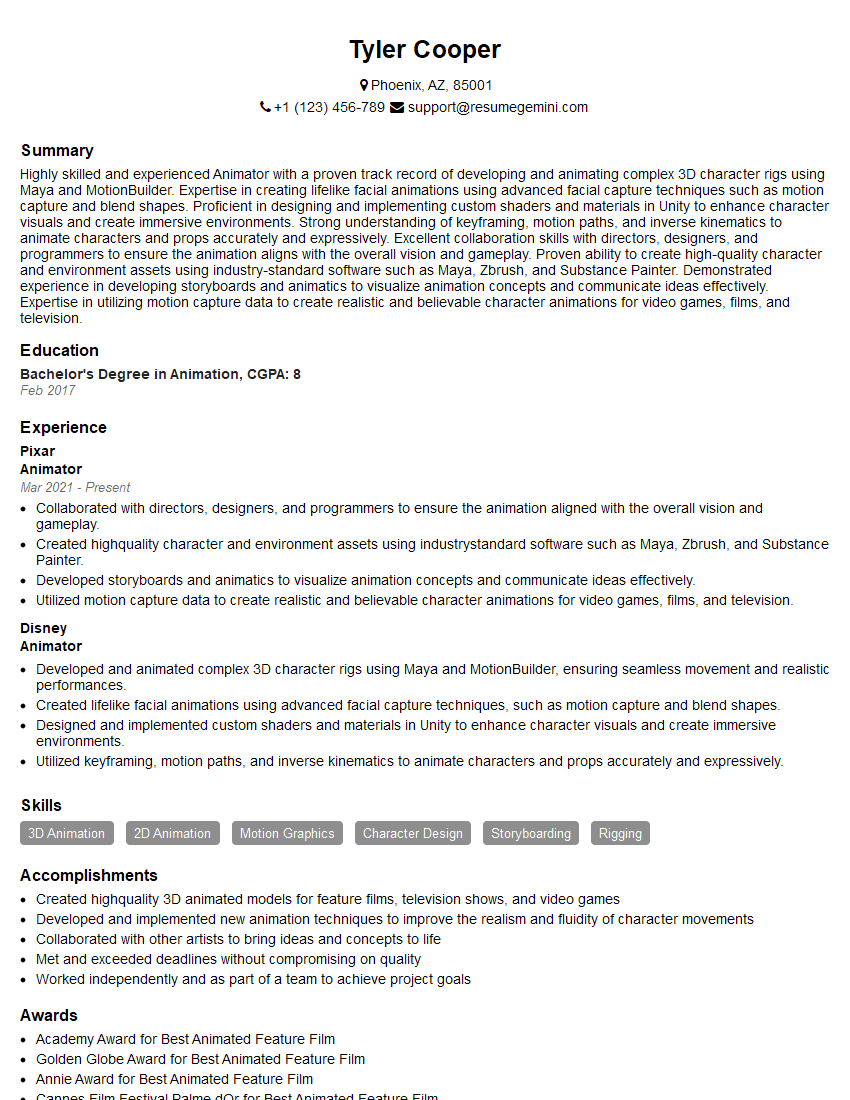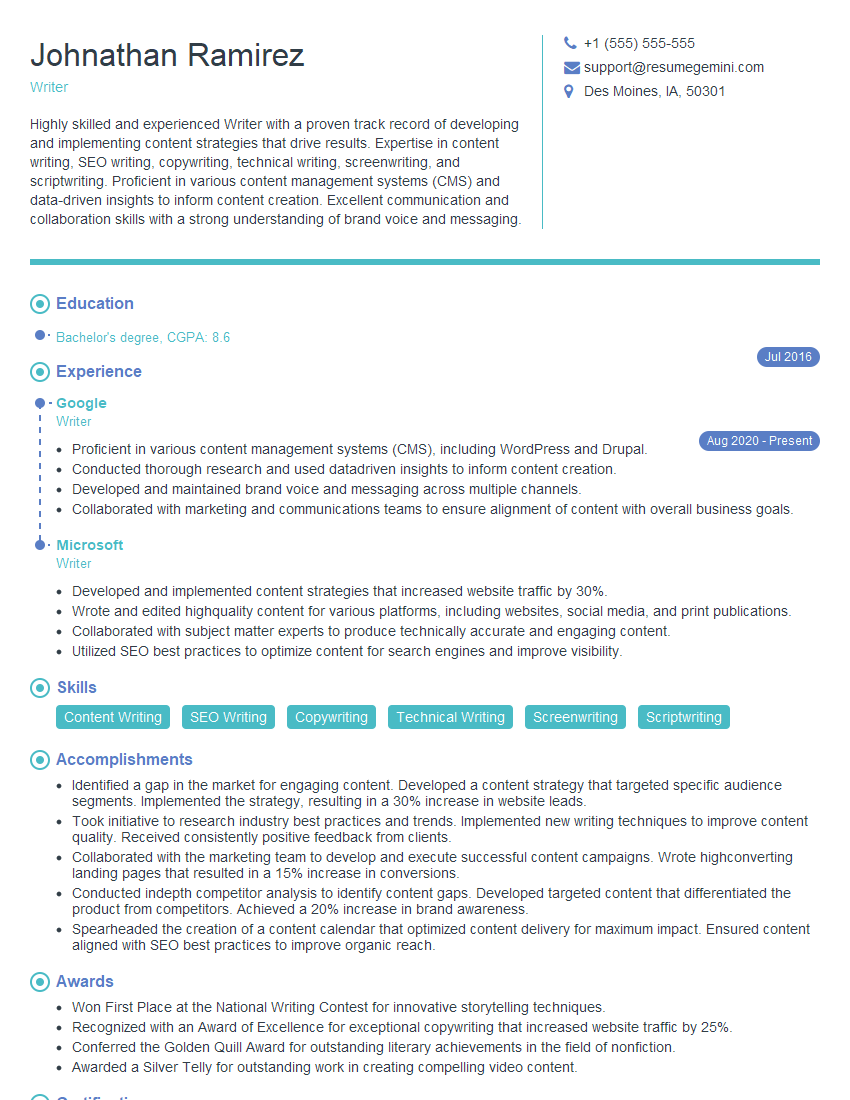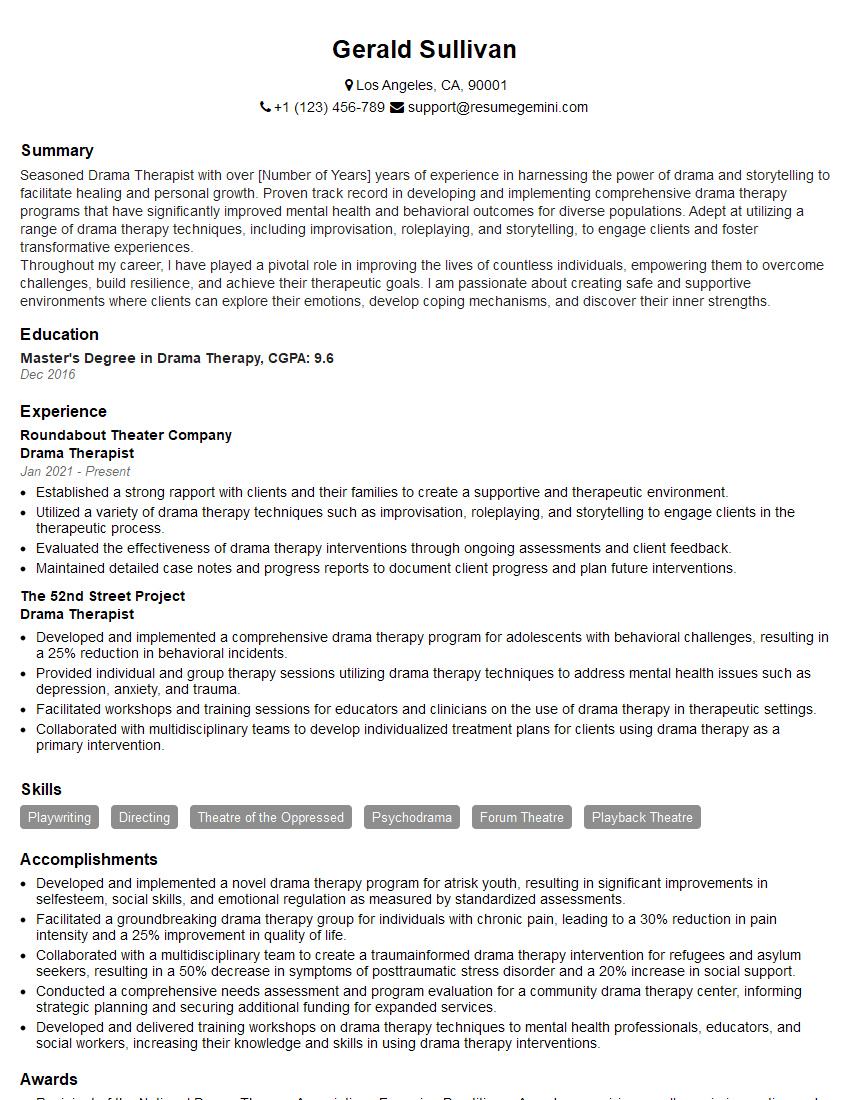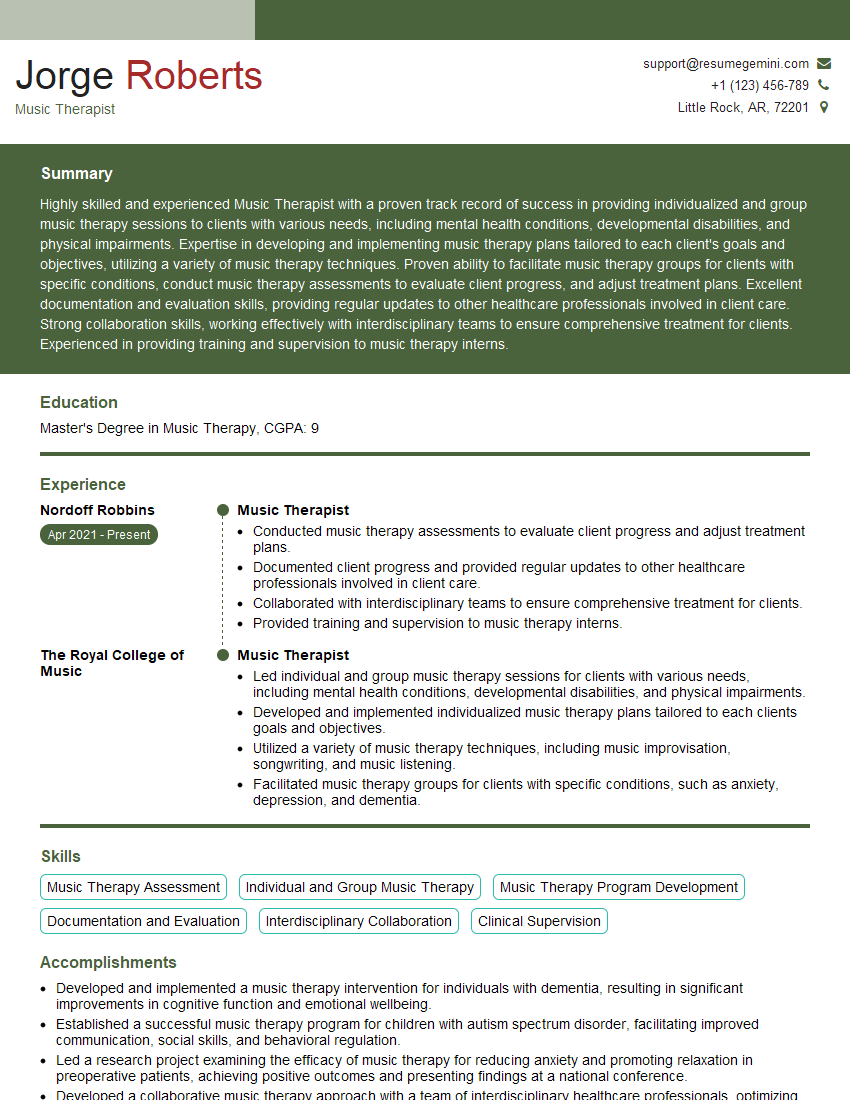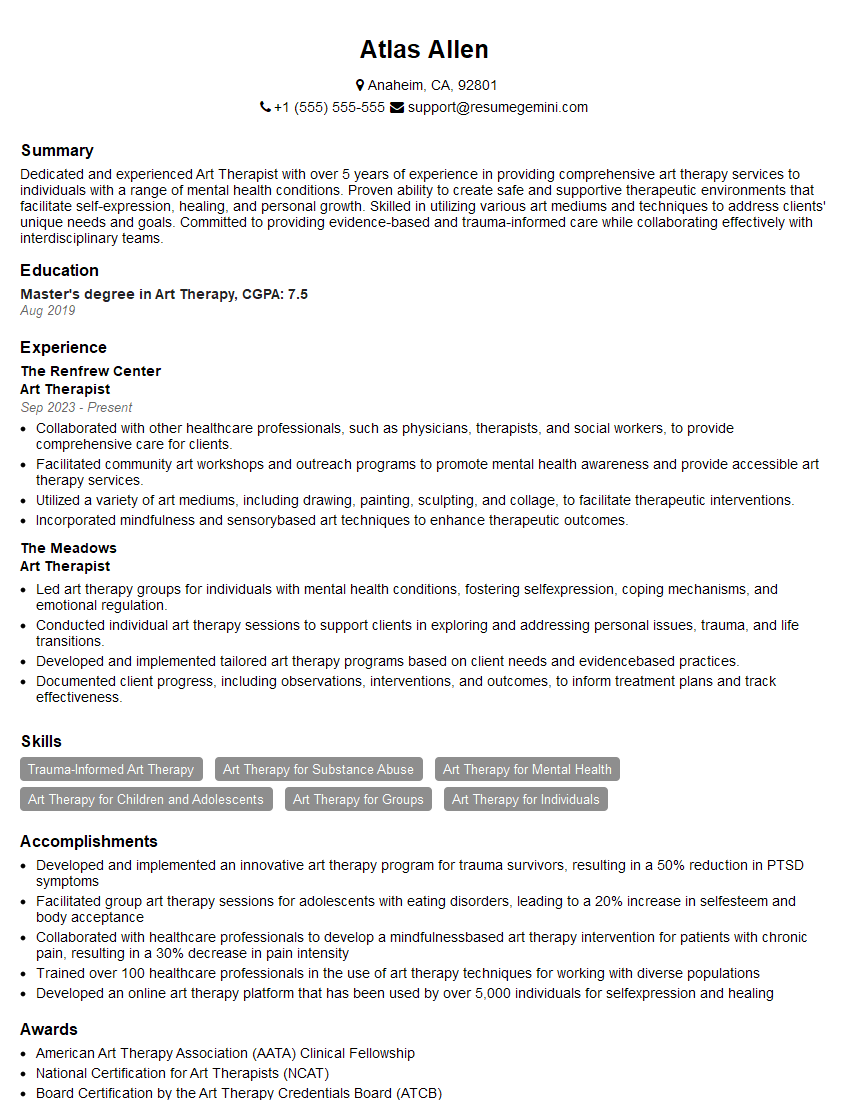Every successful interview starts with knowing what to expect. In this blog, we’ll take you through the top Encouraging creativity and self-expression interview questions, breaking them down with expert tips to help you deliver impactful answers. Step into your next interview fully prepared and ready to succeed.
Questions Asked in Encouraging creativity and self-expression Interview
Q 1. Describe your experience designing a program to encourage creative problem-solving within a team.
Designing a program to encourage creative problem-solving within a team requires a multifaceted approach that blends structured activities with opportunities for free exploration. My experience involves creating a program built on three pillars: brainstorming techniques, constructive feedback mechanisms, and celebration of diverse ideas.
Firstly, I introduced various brainstorming methods such as SCAMPER (Substitute, Combine, Adapt, Modify, Put to other uses, Eliminate, Reverse), mind mapping, and lateral thinking puzzles. These structured approaches help overcome initial inertia and generate a wider range of ideas. For example, when tackling a marketing challenge for a new product, we used SCAMPER to explore unconventional advertising strategies, leading to a highly successful social media campaign.
Secondly, I implemented a system for providing constructive criticism. Instead of direct judgment, we focused on using feedback frameworks like the ‘STAR’ method (Situation, Task, Action, Result) to offer specific, actionable suggestions for improvement. This process fostered a safe space for experimentation and risk-taking.
Finally, the program emphasized celebrating the diversity of ideas generated, regardless of their immediate feasibility. Recognizing and valuing each contribution, even seemingly unconventional ones, cultivated a team environment where creativity was not only encouraged but also appreciated and nurtured.
Q 2. How would you assess an individual’s level of creative self-expression?
Assessing an individual’s level of creative self-expression is a nuanced process that goes beyond simply judging the output. It requires considering both the process and the product of their creative work, as well as their attitude towards creative exploration.
I use a multi-pronged approach:
- Observing their work process: Do they readily experiment? Are they willing to take risks? Do they embrace failure as a learning opportunity?
- Analyzing their creative outputs: This involves examining the originality, complexity, and emotional depth of their work. However, I avoid imposing subjective standards of beauty or perfection. Instead, I look for evidence of personal expression and authentic voice.
- Assessing their self-perception: How do they describe their own creativity? Are they confident in their abilities? Do they view themselves as creative individuals? A self-assessment questionnaire can be a helpful tool in this area.
Ultimately, the goal is not to assign a numerical score but rather to understand the individual’s creative strengths, challenges, and potential for growth. A holistic approach, combining qualitative and quantitative data, provides the most comprehensive assessment.
Q 3. What strategies do you employ to overcome creative blocks in yourself and others?
Creative blocks are common, but they’re surmountable. My strategies involve a combination of mental exercises, environmental shifts, and collaborative approaches.
For myself, I often engage in mindfulness practices like meditation to clear my mind and reduce mental clutter. I also find that changing my physical environment – taking a walk in nature, working in a different location – can spark new ideas. Sometimes, I simply need to step away from the project entirely for a while, allowing my subconscious to work on the problem.
When helping others overcome creative blocks, I employ techniques such as:
- Freewriting or sketching: Encourage uninhibited expression, without focusing on quality or coherence.
- Mind mapping or brainstorming: To visually organize thoughts and uncover new connections.
- Role-playing or perspective shifting: To explore the problem from different angles.
- Collaborative problem-solving: Bringing in fresh perspectives from others.
The key is to create a supportive environment where individuals feel comfortable taking risks and experimenting without fear of judgment.
Q 4. Explain how you would create a safe and inclusive environment for creative expression.
Creating a safe and inclusive environment for creative expression is paramount. It requires establishing clear guidelines and fostering a culture of respect and understanding. My approach focuses on:
- Clear communication of expectations: Setting ground rules that emphasize respect, active listening, and constructive feedback.
- Promoting psychological safety: Creating a space where individuals feel comfortable taking risks without fear of ridicule or judgment. This includes explicitly stating that mistakes are opportunities for learning.
- Valuing diversity: Recognizing and appreciating the unique perspectives and experiences that each individual brings. This requires active efforts to ensure representation and inclusivity.
- Providing access to resources: Ensuring everyone has access to the necessary tools and materials for creative expression.
- Offering diverse creative outlets: Presenting a range of creative methods and mediums to cater to different preferences and learning styles.
For example, I might use anonymous feedback mechanisms to allow for honest expression without fear of personal repercussions. I might also incorporate diverse cultural elements into activities to foster cross-cultural understanding and appreciation.
Q 5. How do you measure the effectiveness of a creativity-enhancing initiative?
Measuring the effectiveness of a creativity-enhancing initiative requires a multifaceted approach that combines quantitative and qualitative data. Simple metrics alone are insufficient; we need a broader perspective.
Quantitative measures might include:
- Number of ideas generated: Provides a basic measure of output.
- Innovation rate: Measures the percentage of ideas implemented that are novel or significantly improve existing processes.
- Employee engagement scores: Gauges participants’ satisfaction and perceived impact of the program.
Qualitative measures are equally crucial and provide a richer understanding:
- Feedback surveys: Gather participants’ perspectives on the program’s effectiveness and areas for improvement.
- Observations of team dynamics: Monitor changes in communication, collaboration, and risk-taking behavior.
- Analysis of creative outputs: Assess the quality, originality, and impact of the creative work produced.
By combining these quantitative and qualitative data points, we can gain a holistic view of the program’s success in fostering creativity and innovation.
Q 6. Describe a time you had to adapt your approach to fostering creativity based on individual needs.
During a team-building workshop, I noticed one participant, Sarah, was consistently hesitant to contribute ideas during brainstorming sessions, despite showing obvious talent in her individual work. My initial approach of using group-based brainstorming techniques proved ineffective for her.
I adapted my approach by providing Sarah with individual time for ideation before group discussions. I also gave her the option to present her ideas anonymously or through visual representations, rather than verbal contributions, recognizing her preference for a less direct communication style.
This change was pivotal. Sarah began to participate more actively, contributing valuable and original ideas. This experience reinforced the importance of personalized approaches to fostering creativity, recognizing that individual needs and preferences significantly impact participation and success.
Q 7. What techniques do you use to inspire creative thinking in diverse groups?
Inspiring creative thinking in diverse groups necessitates an approach that acknowledges and celebrates differences. My strategies involve:
- Structured improvisation exercises: These can be tailored to various learning styles and comfort levels. Simple games, like ‘yes, and…’ can encourage playful exploration and collaboration.
- Cross-cultural problem-solving: Presenting scenarios with cultural contexts to encourage empathy and understanding of diverse perspectives.
- Visual brainstorming tools: Mind maps, concept sketches, and mood boards cater to visual learners and offer non-verbal avenues for expression.
- Storytelling and narrative techniques: Engaging stories can stimulate imagination and connect diverse individuals through shared emotional experiences.
- Emphasizing active listening and inclusive communication: Clear communication guidelines help ensure that everyone feels heard and valued.
By incorporating diverse methods and creating a supportive environment that prioritizes inclusivity, I aim to empower every member of a diverse group to contribute meaningfully to the creative process.
Q 8. How do you handle conflict arising from differing creative ideas?
Conflict stemming from diverse creative ideas is inevitable and, in fact, often fuels innovation. My approach centers on fostering a culture of respectful disagreement and collaborative problem-solving. I begin by ensuring everyone feels safe to express their ideas without fear of judgment. This involves establishing clear ground rules for discussions, emphasizing active listening, and promoting empathy.
Once all ideas are on the table, I guide the team through a structured process to analyze the strengths and weaknesses of each approach. This might involve using a SWOT analysis (Strengths, Weaknesses, Opportunities, Threats) or a simple pros and cons list. We then look for ways to synthesize the best elements of various ideas into a cohesive whole, rather than choosing just one and discarding the rest. For example, if one idea excels in visual appeal and another in functionality, we explore how to integrate both aspects. Finally, we arrive at a consensus-driven decision, ensuring everyone understands the rationale behind the final choice. This process not only resolves the immediate conflict but also strengthens teamwork and builds a more resilient creative environment.
Q 9. Explain your approach to providing constructive feedback on creative work.
Providing constructive feedback on creative work requires a delicate balance between honesty and encouragement. My approach is built on the ‘sandwich method’: starting with positive reinforcement, moving to areas needing improvement, and concluding with another positive note. I focus on specifics, avoiding vague critiques. Instead of saying ‘this is boring,’ I might say, ‘the pacing feels slow in the first act; perhaps we could consider shortening this section or adding a more engaging element here.’
I emphasize the ‘why’ behind my feedback, explaining how the suggestions might enhance the piece’s impact or better communicate its message. I also encourage a two-way conversation, inviting the creator to share their perspective and vision. Finally, I always frame feedback as an opportunity for growth and learning, focusing on achievable improvements rather than dwelling on inherent flaws. This approach transforms the feedback session into a collaborative process, empowering the creator to develop their skills and improve their work.
Q 10. Describe your experience using creative tools or technologies to enhance self-expression.
Throughout my career, I’ve leveraged a variety of creative tools and technologies to enhance self-expression and facilitate collaborative projects. For visual art, I’m proficient in Adobe Creative Suite (Photoshop, Illustrator, InDesign), enabling me to transform ideas into compelling visuals. For video and animation, I have experience with After Effects and Premiere Pro, allowing for the creation of dynamic and engaging content. In music production, I’ve used digital audio workstations (DAWs) like Ableton Live and Logic Pro X to compose and produce original music.
Beyond individual tools, I’m also adept at using collaborative platforms like Miro and Mural for brainstorming and visual project management. These tools are invaluable in fostering a shared creative space, where team members can contribute ideas, provide feedback, and track progress in real-time. The use of such technologies allows for greater efficiency and improved communication during creative processes.
Q 11. How do you integrate creative thinking into the decision-making process?
Integrating creative thinking into decision-making is crucial for generating innovative and effective solutions. I achieve this by employing several techniques. First, I actively encourage ‘lateral thinking,’ or exploring unconventional approaches to problems. This often involves brainstorming sessions, where we aim for quantity over quality initially, embracing even the seemingly outlandish ideas. Then, we systematically evaluate these ideas, looking for connections, synergies, and unexpected possibilities.
I often use visual aids like mind maps or concept sketches to facilitate this process, making the complex thought processes more tangible and accessible to the team. Furthermore, I incorporate prototyping and rapid iteration into the decision-making process, allowing us to test ideas quickly and cheaply before investing significant resources. This approach reduces risk and enables continuous learning and improvement, leading to more informed and imaginative decisions.
Q 12. What are some common barriers to creative self-expression, and how do you address them?
Several barriers frequently hinder creative self-expression. Fear of judgment is a common one, stemming from insecurities about one’s abilities or the potential for negative feedback. Lack of confidence can also be a major obstacle, especially for individuals who haven’t had sufficient opportunities to develop their creative skills. Time constraints and lack of resources, like appropriate tools or materials, can also stifle creativity. Finally, rigid structures or environments that discourage experimentation and risk-taking can significantly inhibit self-expression.
To address these barriers, I focus on building a supportive and encouraging environment. This involves fostering a culture of psychological safety, where individuals feel comfortable taking risks and sharing their ideas without fear of ridicule. Providing access to resources and training, offering mentorship opportunities, and promoting a growth mindset are also crucial strategies. It’s about empowering individuals to overcome their self-doubt and unleash their full creative potential.
Q 13. How do you support the development of creative leadership within a team?
Developing creative leadership within a team involves cultivating several key qualities. Firstly, I encourage visionary thinking, prompting team members to consider the bigger picture and identify opportunities for innovation. Secondly, I emphasize empathy and collaboration, fostering an environment where team members feel valued, understood, and empowered to contribute their unique perspectives. Thirdly, I promote effective communication, enabling clear articulation of ideas and seamless teamwork. Finally, I emphasize the importance of taking calculated risks and embracing experimentation.
This development process often involves mentoring and coaching individual team members, providing them with the tools and guidance they need to hone their leadership skills. It also includes creating opportunities for them to take on leadership roles within projects, gradually increasing their responsibilities and providing constructive feedback along the way. This approach fosters growth and builds a team of empowered creative leaders.
Q 14. Describe your experience in facilitating brainstorming sessions that generate innovative solutions.
Facilitating brainstorming sessions that generate innovative solutions requires careful planning and execution. I begin by clearly defining the problem or challenge, ensuring everyone understands the goal. Then, I establish a set of ground rules to encourage participation and prevent domination by a few individuals. These rules often include guidelines for respecting all ideas, brainstorming individually before group discussion, and building upon others’ ideas.
I utilize a variety of brainstorming techniques, including mind mapping, SCAMPER (Substitute, Combine, Adapt, Modify, Put to other uses, Eliminate, Reverse), and the six thinking hats method, to stimulate diverse thinking perspectives. Throughout the session, I actively manage the flow of ideas, ensuring everyone has a chance to contribute and that the discussion remains focused. Finally, I summarize the key ideas generated, prioritizing and categorizing them for further discussion and development. This structured approach ensures that brainstorming sessions are productive and result in a wealth of innovative solutions.
Q 15. How do you encourage risk-taking and experimentation in a creative environment?
Encouraging risk-taking and experimentation is crucial for fostering a thriving creative environment. It’s about creating a culture where failure is seen not as an endpoint, but as a valuable learning opportunity. This starts with establishing psychological safety – a space where individuals feel comfortable taking chances without fear of judgment or reprimand.
- Provide clear guidelines but avoid rigid rules: Offer frameworks and parameters, but allow room for exploration within those boundaries. Think of it as providing a sandbox, not a cage.
- Celebrate experimentation: Publicly acknowledge and reward attempts, even if they don’t yield the desired outcome. Focus on the process and learning gained.
- Implement ‘fail fast, learn fast’ methodologies: Encourage quick prototyping and iteration. This allows for rapid testing and adjustments, minimizing the impact of potential failures.
- Lead by example: Demonstrate your own willingness to take risks and experiment. Your actions speak louder than words.
- Provide resources and support: Offer training, tools, and mentorship to help individuals navigate the experimental process.
For example, in a design team, I might challenge the team to explore unconventional materials or techniques for a new product. Even if the initial experiments don’t lead to a perfect solution, the learning and innovative approaches gained will enrich future projects.
Career Expert Tips:
- Ace those interviews! Prepare effectively by reviewing the Top 50 Most Common Interview Questions on ResumeGemini.
- Navigate your job search with confidence! Explore a wide range of Career Tips on ResumeGemini. Learn about common challenges and recommendations to overcome them.
- Craft the perfect resume! Master the Art of Resume Writing with ResumeGemini’s guide. Showcase your unique qualifications and achievements effectively.
- Don’t miss out on holiday savings! Build your dream resume with ResumeGemini’s ATS optimized templates.
Q 16. How do you motivate individuals to share their creative ideas openly and honestly?
Motivating open and honest sharing of creative ideas requires building trust and establishing a culture of respect and psychological safety. People need to feel their contributions are valued, regardless of whether they’re deemed ‘good’ or ‘bad’ initially.
- Create a safe space for vulnerability: Emphasize that it’s okay to share incomplete or even seemingly ‘silly’ ideas. Frame brainstorming as a collaborative exploration, not a competition.
- Implement anonymous idea generation techniques: Tools like online suggestion boxes or anonymous feedback forms can encourage participation from those who may be hesitant to speak up directly.
- Active listening and respectful feedback: Train team members in effective communication skills, focusing on active listening and constructive criticism. Avoid immediately dismissing ideas – explore their potential first.
- Focus on the ‘why’ behind ideas: Encourage individuals to explain the reasoning and inspiration behind their ideas. This context can spark further collaboration and innovation.
- Implement a ‘no judgment’ rule during brainstorming: Create a clear understanding that all ideas are welcome without immediate critique.
For instance, I once used a ’round robin’ brainstorming technique where each team member contributed one idea at a time, creating a space for every voice to be heard without interruption.
Q 17. What is your approach to integrating creativity into a structured work environment?
Integrating creativity into a structured work environment requires a delicate balance. The key is to leverage the benefits of structure while creating opportunities for creative expression. It’s not about abandoning structure, but about thoughtfully weaving creativity into the existing framework.
- Allocate dedicated time for creative thinking: Schedule regular brainstorming sessions or ‘innovation sprints’ to provide focused time for creative work.
- Encourage cross-functional collaboration: Bringing together individuals with diverse backgrounds and skillsets can spark unexpected insights and creative solutions.
- Incorporate creative problem-solving methodologies: Techniques like design thinking, SCAMPER (Substitute, Combine, Adapt, Modify, Put to other uses, Eliminate, Reverse), or lateral thinking can be used to approach problems from different perspectives.
- Use visual aids and collaborative tools: Whiteboards, mind maps, and collaborative online tools can facilitate the creative process and make it more engaging.
- Recognize and reward creative contributions: Celebrate successes and acknowledge the value of creative thinking in achieving business goals.
For example, in a project management setting, I might incorporate a ‘design thinking’ workshop to explore user needs and develop innovative solutions before moving into detailed project planning.
Q 18. Explain how you’ve used creative methods to improve team communication and collaboration.
I’ve used several creative methods to improve team communication and collaboration, focusing on techniques that facilitate visual communication and playful engagement.
- Visual storytelling: Encouraging teams to create visual representations of their projects (e.g., flowcharts, storyboards, concept maps) can make complex information more accessible and engaging.
- Gamification: Introducing game-like elements (e.g., points, badges, leaderboards) into project management can increase motivation and make collaboration more fun.
- Role-playing and simulations: Simulating real-world scenarios can help teams develop empathy and understand diverse perspectives.
- Improvisation exercises: Improvisation games can help break down communication barriers and encourage spontaneous problem-solving.
- Creative workshops and team-building activities: Engaging in collaborative creative activities, such as painting, sculpting, or building, can foster team bonding and improve communication.
In one project, we used a Lego Serious Play workshop to help a team visualize their project goals and identify potential challenges. The hands-on nature of the activity stimulated communication and resulted in a much clearer understanding of the project scope and tasks.
Q 19. How do you nurture creative talent within a team or organization?
Nurturing creative talent involves providing opportunities for growth, mentorship, and recognition. It’s about creating an environment where individuals feel supported and empowered to develop their creative skills.
- Provide opportunities for skill development: Offer training programs, workshops, or access to online resources to help individuals expand their creative skillsets.
- Mentorship and coaching: Pair individuals with experienced mentors or coaches who can provide guidance and support their creative journey.
- Create opportunities for experimentation and exploration: Encourage individuals to pursue side projects, attend creative events, or engage in personal creative endeavors.
- Recognition and rewards: Acknowledge and celebrate creative achievements, both big and small. This can involve public recognition, awards, or simply a sincere expression of appreciation.
- Create a culture of continuous learning: Foster a culture where learning and growth are valued, encouraging individuals to continuously seek out new knowledge and experiences.
For example, I once established a ‘creative fund’ within my team, allowing members to apply for funding to pursue personal creative projects that could potentially benefit the team or organization in the future.
Q 20. Describe your understanding of different creative thinking styles and how you adapt to them.
Understanding different creative thinking styles is crucial for adapting my approach and fostering inclusivity. There’s no single ‘right’ way to think creatively; different individuals thrive in different environments and approaches.
- Divergent thinking: This involves generating a wide range of ideas, often without immediate judgment. I encourage this through brainstorming sessions and mind-mapping.
- Convergent thinking: This focuses on narrowing down ideas to arrive at the best solution. I use techniques like decision matrices and prioritization frameworks to support this process.
- Lateral thinking: This involves approaching problems from unconventional angles, challenging assumptions, and breaking free from established patterns. I stimulate this through creative problem-solving techniques like SCAMPER.
- Intuitive thinking: This relies on gut feelings and instincts. I encourage individuals to trust their intuition and share their initial ideas, even if they lack a fully developed rationale.
I adapt to different styles by providing a range of tools and techniques and creating a space where all approaches are valued. For instance, I might use a visual brainstorming session for a team that’s more visually oriented, while employing a more structured, data-driven approach for a team that’s more analytical.
Q 21. How do you incorporate elements of play and fun to enhance creativity?
Incorporating play and fun is essential for unlocking creativity. It reduces stress, enhances engagement, and allows for more spontaneous and innovative ideas to emerge.
- Use playful activities as icebreakers: Starting meetings or workshops with a fun game or activity can create a more relaxed and engaging atmosphere.
- Encourage playful experimentation: Provide opportunities for individuals to experiment and explore ideas without pressure to deliver a perfect outcome.
- Create a playful workspace: A workspace that incorporates elements of fun and playfulness can encourage a more creative and relaxed environment.
- Use humor and lightheartedness: Incorporating humor and a lighthearted approach can make the creative process more enjoyable and less intimidating.
- Embrace failure as a learning opportunity: Creating a culture where failure is seen as a stepping stone rather than a setback allows for more playful exploration.
For example, I might organize a team-building activity that involves building a structure from unusual materials, fostering collaboration and promoting a playful approach to problem-solving.
Q 22. What are some metrics you would use to evaluate the success of a creative project?
Evaluating the success of a creative project goes beyond simply measuring sales or profit. It requires a multifaceted approach, considering both quantitative and qualitative factors.
- Quantitative Metrics: These are measurable data points. Examples include website traffic (for a digital project), number of units sold (for a product), audience engagement (likes, shares, comments on social media), project completion rate on time and within budget.
- Qualitative Metrics: These assess the impact and user experience. Examples include user feedback surveys (measuring satisfaction and identifying areas for improvement), focus group discussions (gathering in-depth insights into user perception), critical reviews (professional assessments of the work’s quality and originality), and the extent to which the project achieved its intended creative goals (innovation, emotional impact, artistic merit).
For example, a successful marketing campaign might show a significant increase in brand awareness (qualitative) alongside a measurable boost in sales (quantitative). A successful art installation might be judged by the number of visitors (quantitative) but also the critical acclaim and emotional response it generated (qualitative).
Q 23. Explain how you build confidence in individuals to express their creative ideas.
Building confidence in creative expression requires fostering a safe and supportive environment where individuals feel comfortable taking risks without fear of judgment. This involves:
- Creating a psychologically safe space: Emphasize that experimentation and even ‘failure’ are vital parts of the creative process. Normalize mistakes as learning opportunities. Active listening and showing genuine interest in individual ideas are crucial.
- Providing positive reinforcement: Focus on effort and progress, not just outcomes. Celebrate small wins and acknowledge individual contributions. Offer specific, constructive feedback rather than general criticism.
- Promoting collaboration and peer support: Encourage brainstorming sessions and group projects where individuals can learn from and support each other. Pair individuals with mentors or more experienced team members for guidance and encouragement.
- Highlighting diverse perspectives and approaches: Showcase the value of unique viewpoints and encourage individuals to embrace their own creative styles. Demonstrating the impact of diverse ideas and experiences expands confidence.
Think of it like learning to ride a bike. Falling is part of the process, but with encouragement and practice, confidence grows.
Q 24. Describe your experience using different creative methodologies (e.g., Design Thinking, SCAMPER).
I have extensive experience applying various creative methodologies, including Design Thinking and SCAMPER.
- Design Thinking: I utilize the five stages – empathize, define, ideate, prototype, test – to approach creative challenges systematically. For example, when designing a new user interface, I’d begin by understanding user needs (empathize), define the problem, brainstorm solutions (ideate), build a prototype, and gather user feedback (test) before finalizing the design. This iterative process ensures user-centric solutions.
- SCAMPER: This checklist – Substitute, Combine, Adapt, Modify, Put to other uses, Eliminate, Reverse – helps to generate innovative ideas by systematically exploring different aspects of an existing product or process. For instance, when tasked with improving a company’s internal communication system, I used SCAMPER to explore various modifications. By adapting elements from other successful communication platforms (Adapt), and eliminating unnecessary features (Eliminate), we streamlined the system and improved efficiency.
My experience shows that combining these methodologies, tailoring them to the specific context, and understanding the project’s unique demands, produces the most effective and creative outcomes.
Q 25. How would you handle a situation where a team member is reluctant to share their creative ideas?
A team member’s reluctance to share ideas stems from various factors, including fear of judgment, lack of confidence, or past negative experiences. My approach focuses on building trust and creating a safe environment.
- One-on-one conversation: I’d initiate a private conversation to understand the reason for their hesitation. Empathetic listening is crucial.
- Building rapport: I’d focus on building trust by sharing my own experiences and vulnerabilities, creating a connection that encourages open communication.
- Reframing the context: I’d reframe idea sharing not as a performance but as a collaborative process. Emphasize that all ideas are valuable contributions, even if they are not ultimately implemented.
- Providing structured support: I might suggest starting with small contributions, anonymous idea submission, or working on a smaller, less high-pressure project to help build confidence.
- Positive reinforcement: Once they contribute, I’d provide positive feedback and showcase how their idea contributed positively to the project.
The key is patience and understanding. Forcing participation will only create further resistance. A supportive, collaborative approach is far more effective.
Q 26. Describe a time you successfully mentored someone to improve their creative skills.
I mentored a junior graphic designer who lacked confidence in their artistic abilities. They were hesitant to share their work and often self-criticized harshly.
My approach was multi-pronged:
- Focused feedback: Instead of general criticism, I provided specific, constructive feedback, focusing on the strengths of their work and identifying areas for improvement. I used the “sandwich method” — starting with positive feedback, then offering constructive criticism, and ending with encouragement.
- Exploration of different styles: We explored diverse design styles and techniques, helping them discover their unique aesthetic and build confidence in their individual style.
- Setting achievable goals: I helped them set small, manageable goals, celebrating each achievement along the way. This gradually built confidence and momentum.
- Portfolio development: We worked together to build a strong portfolio that showcased their evolving skills and creative style.
By the end of the mentorship, their confidence had significantly improved. Their design work became more refined, and they confidently presented their ideas and actively participated in team discussions. Their portfolio secured them a promotion.
Q 27. How do you adapt your approach to encouraging creativity based on the organizational culture?
Adapting my approach to different organizational cultures is crucial for effectively encouraging creativity. A hierarchical, risk-averse environment requires a different approach than a flat, collaborative one.
- Hierarchical Cultures: In these cultures, I might focus on aligning creative projects with strategic organizational goals, demonstrating the value of innovation to leadership, and advocating for dedicated time for creative exploration.
- Collaborative Cultures: In these environments, I’d foster open communication, encourage cross-functional collaboration, and create spaces for brainstorming and experimentation. I’d leverage the existing collaborative spirit to build on existing momentum.
- Risk-Averse Cultures: In such cultures, I’d introduce creative initiatives gradually, highlighting successes from similar projects in other organizations. I’d frame creative risks as calculated opportunities rather than threats, focusing on mitigating potential downsides.
Understanding the organizational culture’s values, communication styles, and power dynamics is essential for adapting my methods effectively and fostering a culture of creative innovation.
Q 28. What are your thoughts on the role of technology in facilitating creative self-expression?
Technology plays a transformative role in facilitating creative self-expression. It provides unprecedented tools and platforms for creation, collaboration, and dissemination.
- Accessibility: Digital tools make creative tools readily available, democratizing access to creative expression regardless of geographical location or economic constraints. Anyone with a smartphone can create and share their work.
- Enhanced capabilities: Software and applications offer a vast array of features enabling complex creations that would be impossible using traditional methods. Imagine the possibilities of digital sculpting or AI-assisted music composition.
- Collaboration and dissemination: Digital platforms facilitate global collaboration, allowing creators to connect and share their work with wider audiences. Social media platforms and online marketplaces connect creators with their audience, regardless of geography.
- New forms of expression: Technology has given rise to entirely new forms of creative expression, such as digital art, interactive installations, and virtual reality experiences.
However, it’s important to be mindful of the potential downsides, such as the digital divide and the challenge of managing intellectual property rights in the digital space. Nevertheless, technology’s overall impact on creative self-expression is overwhelmingly positive.
Key Topics to Learn for Encouraging Creativity and Self-Expression Interviews
- Understanding Different Creative Processes: Explore various approaches to fostering creativity, such as brainstorming, mind mapping, design thinking, and improvisation. Consider the strengths and weaknesses of each method.
- Building a Culture of Innovation: Learn how to create an environment where individuals feel safe to take risks, experiment, and share ideas without fear of judgment. Discuss practical strategies for implementing such a culture.
- Providing Constructive Feedback: Master the art of giving feedback that is both supportive and challenging. Learn how to offer criticism that helps individuals grow and improve without discouraging them.
- Identifying and Overcoming Creative Blocks: Explore common obstacles to creativity and learn practical techniques to help individuals overcome them. This includes understanding individual differences and personalized approaches.
- Measuring and Evaluating Creative Output: Discuss methods for assessing the effectiveness of creative initiatives and the impact on team performance or organizational goals. Consider both qualitative and quantitative measures.
- Utilizing Technology to Enhance Creativity: Explore how various technologies can be leveraged to support and enhance creative processes, collaboration, and idea generation.
- Adapting to Diverse Creative Styles: Understand how to work effectively with individuals who possess different creative approaches and preferences. This involves valuing diverse perspectives and finding common ground.
Next Steps
Mastering the art of encouraging creativity and self-expression is crucial for career advancement in many fields, fostering innovation and high-performing teams. A strong resume showcasing your understanding of these principles is essential. Build an ATS-friendly resume that highlights your relevant skills and experience using ResumeGemini, a trusted resource for crafting professional resumes. Examples of resumes tailored to showcasing expertise in encouraging creativity and self-expression are available to help you build your own compelling application.
Explore more articles
Users Rating of Our Blogs
Share Your Experience
We value your feedback! Please rate our content and share your thoughts (optional).
What Readers Say About Our Blog
good


